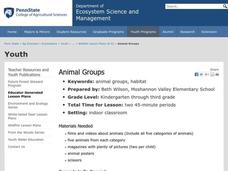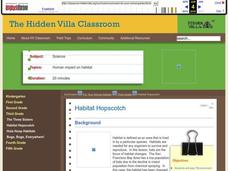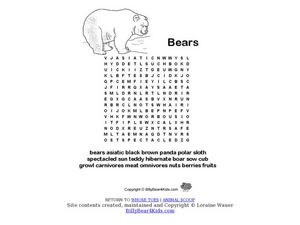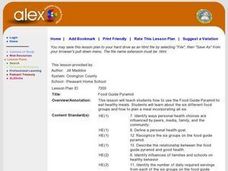Curated OER
Animal Skulls
Pictures of different animal skulls make this slide show fascinating. The intent is to display the differences in structure among herbivores, carnivores, and omnivores. If you do not have animal skull replicas, this presentation would be...
Curated OER
Fun With Food Chains
Students explore our ecosystem by researching animal eating habits. In this food chain lesson plan, students identify the links between predator and prey and the energy that passes between organisms based on what their diet consists of....
Curated OER
Dining Out With Fishes and Birds of the Hudson
The class will make observations to determine how environment has shaped the way particular birds and fish eat. They will view a series of photographs, read two short articles, and then consider how food availability has determined how...
Curated OER
Is It Ethical to Eat Meat?
Have your class join a blog about whether or not eating meat is good for you. They'll read several passages regarding meat processing and consumption, then they post what they think. There are six critical-thinking prompts to help them...
Curated OER
Seven Habits of Highly Effective Teens Worksheet
Based on the bestselling series, this worksheet details seven habits of highly defective teens, and prompts young learners to consider their own social and emotional tendencies. What kinds of experiences do your pupils have...
Curated OER
Food Chain Game
Students explore animal characteristics by participating in a role-play activity. In this food chain lesson plan, students discuss the order of life and how animals must eat other animals to survive. Students conduct a food chain game in...
Curated OER
Inquiry in Science Using an Animal Behavior Model
Young scholars observe a planaria without a microscope and with a stereoscopic microscope. They draw the planaria and describe its motion and eating habits. Students research planarias various body systems and behavior. They design an...
Curated OER
Animal Groups
Learners explore animal groups. For this animal science lesson, students use pictures from magazines and classify the animals into five categories. Learners share why they categorized the animals the way they did.
Curated OER
Wild Where?
Students investigate why the urban environment is considered a hostile environment; define the concept of endangered species; describe and identify a Peregrine Falcon; describe and identify the eating habits of the Peregrine Falcon.
American Museum of Natural History
A Whale of a Tale
What's the most interesting fact about a blue whale? Learners read an interview about the similarities between the Titanosaur and the blue whale displays at the American Museum of Natural History. Pupils learn not only about blue whales...
Curated OER
The Feeding of Baby Lions and snakes
Fourth graders view a Count On It! episode and answer a question about the eating habits of animals. In this animal eating problem lesson plan, 4th graders determine how much more often a baby lion eats than a snake. ...
Curated OER
Marshland Ecosystem
Students classify animals based on their physical characteristics and eating habits. In this animal identification lesson plan, students investigate the life forms shown on a Parisian ceramic basin, and discover ecosystem the...
Curated OER
Invent an Insect
Explore biology by researching adaptation. First, learners research and define a list of insect vocabulary terms and discuss the benefits of each insect characteristic. They then utilize a worksheet to create their own insect and share...
Exploring Nature Educational Resources
Building A Classroom Food Web
From bears and owls to chipmunks and trees, all life depends on the sun for the energy to survive. Young biologists develop an understanding of this big idea as they arrange this series of plant and animal picture cards into food...
Curated OER
Classroom Critters Developing Our Writing Skills
Students investigate animals and how it adapts to its environment. They write notes and gather information on a chosen animal. After research is completed, students create a report about the animal's characteristics, appearance, food,...
Curated OER
Turtle Lesson
Students explore the five common turtles that are native to the eastern United States. They investigate each turtle's characteristics, environment, means of protection, eating habits, and show how they can help these turtles survive.
Curated OER
Endangered Species Report
In this science worksheet, learners prepare their report outline on an endangered species, describe their animal's habitat, explain their eating habits as well as the main reason why their animal is an endangered species.
Curated OER
The Giant Panda Word Search
In this panda vocabulary words worksheet, students search for words that identify the giant panda's eating habits, environment, animal classification and descriptive words. Students word search eleven panda vocabulary words.
American Museum of Natural History
What's This? Feeding
Some species have pretty creative methods for catching food. Young scientists learn about some interesting ways organisms get the nutrients they need by navigating an online interactive lesson that would be suitable for a remote learning...
Curated OER
Taking an Animal Census Grades 3-8
Students comprehend the competitive, interdependent, cyclic nature of living things in an environment. They conduct an animal census in a designated research area over a six-month period to determine what types of species are present,...
Curated OER
Habitat Hopscotch
Third graders explore animal characteristics by participating in a bat environment game. In this natural habitat lesson, 3rd graders identify the physical anatomy of a bat and discuss their eating and sleeping habits. Students conduct a...
Curated OER
Getting Food
Students explore seashore ecosystems. In this marine animal biology lesson, students sort photographs of various sea creatures according to their eating habits and discuss each animal's identifiable traits. Students draw and...
Curated OER
Bears Word Search
In this bear vocabulary words worksheet, students search for words describing such things as the bears environment, eating classification, types, habits, and names from baby to adult. Students conduct a word search for twenty-one bear...
Alabama Learning Exchange
Food Guide Pyramid - TV and Peers
Learners identify foods that belong in each group on the food guide pyramid. They discuss how TV and peers may negatively influence eating habits.

























